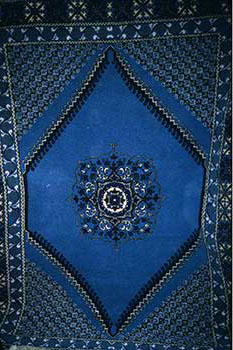Moroccan Markets and the Fez Carpet
 November 15 - 25, 1987
November 15 - 25, 1987
As we walked into the market square at Marrakesh, our senses were assaulted by a myriad of exotic sights and sounds, but the one that seemed to draw us was the wild wailing of the snake charmer's flute. Several colorful snakes were coiled up on mats and a large cobra was swaying back and forth to the music. A bearded and wizened old man with a snake around his neck walked straight up to us (we stood out in every crowd with our white skin) and draped it around Dennis' neck. We'd seen other tourists with the snakes so, although scary, it didn't seem too dangerous. I took Dennis' picture with the snake around his neck, admiring his courage and smiling at his expression of distaste.
It was only later that we read in Traveler's Health that "snakes and snake charmers should be avoided as far as possible...."
The markets and medinas in Marrakesh and Fez were everything I imagined Arab markets to be: miles of narrow winding streets crowded with hundreds of shops selling every conceivable kind of commodity, and thousands upon thousands of people. In tiny shops, woodworkers fashioned articles on foot-powered lathes, old men hammered out brass plates and trays, dyers worked in the vats and hung skeins of every color to drip dry in the sun. Beggars called for alms and heavily loaded donkeys pushed through the streets driven by impatient men with sticks. Musicians danced and played wild exotic music, men with eagles, snakes and monkeys posed for pictures, and veiled women flitted about like shadows.
There were always guides. Boys and young men would come and offer to show us around. We'd invariably say no, we preferred to explore on our own. That didn't deter them a bit. We were hounded and stalked. They were experts at eliciting guilt and extracting money!
In the market, it was dangerous even to look at an item, let alone with interest. Shopkeepers wouldn't take no for an answer. Often, our way was physically blocked as we tried to leave. They demanded we buy their wares. "Shoes. Very good, very cheap. What size you need?" They were extremely offended and even angry if we did not buy. No excuse sufficed. Even if we purchased something, they pushed us to purchase one more for a friend.
 It was endlessly fascinating but emotionally exhausting. We had no peace, no chance to relax.
It was endlessly fascinating but emotionally exhausting. We had no peace, no chance to relax.
Later, in Fez, we visited a centuries-old leather tannery. There was a smell of rot and acid, piles of animal horns and hooves, and flowing streams of something we had to pick our way around.
Men dressed only in shorts waded in pits of white liquid up to their waists, turning and working the hides. Others scraped off meat and hair by hand. To Dennis, it was a vision of hell on earth.
We were taken to a carpet cooperative. Before leaving Alaska, I had considered purchasing an oriental carpet if I could find one I liked. The one in the Quonset hut was more than 75 years old and quite worn.
 I saw a carpet I liked, but it was too small. I was shown many others but nothing interested me until they said they would custom-make the carpet I liked in the size I wanted. It would take six months. I'd be traveling until June so time was no problem. Dennis bargained the price to $1,700.00 for a top quality handmade Fez carpet, 9x12 feet. Unfortunately, the one waiting when we got back to Alaska was a cheap imitation of a top quality handmade Fez carpet, worth only $500 or so. Bait and switch. American Express was of no help in resolving the problem, so we canceled our cards.
I saw a carpet I liked, but it was too small. I was shown many others but nothing interested me until they said they would custom-make the carpet I liked in the size I wanted. It would take six months. I'd be traveling until June so time was no problem. Dennis bargained the price to $1,700.00 for a top quality handmade Fez carpet, 9x12 feet. Unfortunately, the one waiting when we got back to Alaska was a cheap imitation of a top quality handmade Fez carpet, worth only $500 or so. Bait and switch. American Express was of no help in resolving the problem, so we canceled our cards.
We finished the day in Fez at a Turkish bath, a new experience. It cost only 50¢ each. Women and men had separate large steamy rooms decorated with Arab mosaics. Buckets were available to be filled with either hot or cold water, which we dumped all over ourselves and each other, scrubbing and rinsing until we were clean, warm and tingling.
Go on to High Atlas Trek
Source: www.SusanCAnthony.com, ©Susan C. Anthony
